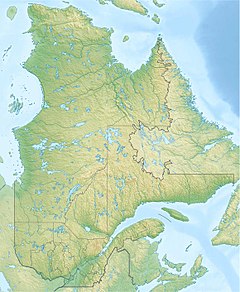| Chicoutimi River | |
|---|---|
 | |
| Location | |
| Country | Canada |
| Province | Quebec |
| Region | Saguenay-Lac-Saint-Jean |
| Regional County Municipality | Le Fjord-du-Saguenay Regional County Municipality |
| City | Saguenay |
| Physical characteristics | |
| Source | Kenogami Lake via Barrage de Portage-des-Roches |
| • location | Saguenay |
| • coordinates | 48°18′35″N 71°12′42″W / 48.3097°N 71.2116°W |
| • elevation | 164 |
| Mouth | Saguenay River |
• location | Saguenay |
• coordinates | 48°25′48″N 71°04′30″W / 48.4301°N 71.0750°W |
• elevation | 87 m (285 ft) |
| Length | 26.2 km (16.3 mi) |
| Discharge | |
| • location | Saguenay |
| Basin features | |
| Tributaries | |
| • left | (from the mouth) Cours d'eau Morin, cours d'eau Brassard, cours d'eau Bédard, cours d'eau Belley, décharge du lac Dallaire. |
| • right | (from the mouth) Ruisseau Gilbert, ruisseau Henriette, décharge du lac Clairval, du lac de la Cave et du Petit lac Moncouche. |
The Chicoutimi River is a watercourse of eastern Quebec, Canada. A tributary of the Saguenay River, which it meets in the city of Saguenay, it is the 26.2-kilometre-long (16.3 mi) main outlet of Kenogami Lake, which rises from a watershed of 3,390 square kilometres (1,310 sq mi) in the Laurentides Wildlife Reserve. Entirely located in the Chicoutimi borough of Saguenay, it is the most urbanized and dammed river in Saguenay–Lac-Saint-Jean.[1]
Used by the Montagnais of the Saguenay River before the arrival of Europeans, it was at that time the first portage from the main access road to Lac Saint-Jean. In the 20th century, it was developed from its source to its mouth for hydropower purposes. In addition to being the source of drinking water for the Chicoutimi and Jonquière boroughs, this river has six dams (including 2 hydroelectric power plants in operation). During the Saguenay flood in 1996, its surge caused significant damage to Laterrière and Chicoutimi.
- ^ Ouellet, Yves. The Saguenay Fjord. Merveille du Québec, Trecarré, 1993, 160 p.

